NURS2004: Kevin Johnson's Discharge Plan - ADLs and MDT Referrals
VerifiedAdded on 2023/06/04
|10
|3026
|113
Report
AI Summary
This nursing assignment discusses effective discharge planning for 15-year-old Kevin Johnson, an indigenous adolescent recovering from a motorbike accident with a fractured leg. The assignment outlines key aspects of a discharge plan, including maintaining hospital standards, establishing rapport with healthcare providers, and coordinating with the discharge planner and family. It uses the nursing process to address Activities of Daily Living (ADLs) relevant to Kevin's condition at discharge, such as bathing, dressing, and mobility, recommending a community helper for initial support. The assignment identifies a multidisciplinary team (MDT) including a community worker, physiotherapist, dietician, pharmacist, and occupational therapist to provide holistic care and promote accelerated recovery. The conclusion emphasizes the importance of a comprehensive discharge plan tailored to the patient's needs, ensuring a smooth transition from the hospital to the home environment.

Running head: NURSING ASSIGNMENT
NURSING ASSIGNMENT
Name of the Student:
Name of the University:
Author Note:
NURSING ASSIGNMENT
Name of the Student:
Name of the University:
Author Note:
Paraphrase This Document
Need a fresh take? Get an instant paraphrase of this document with our AI Paraphraser
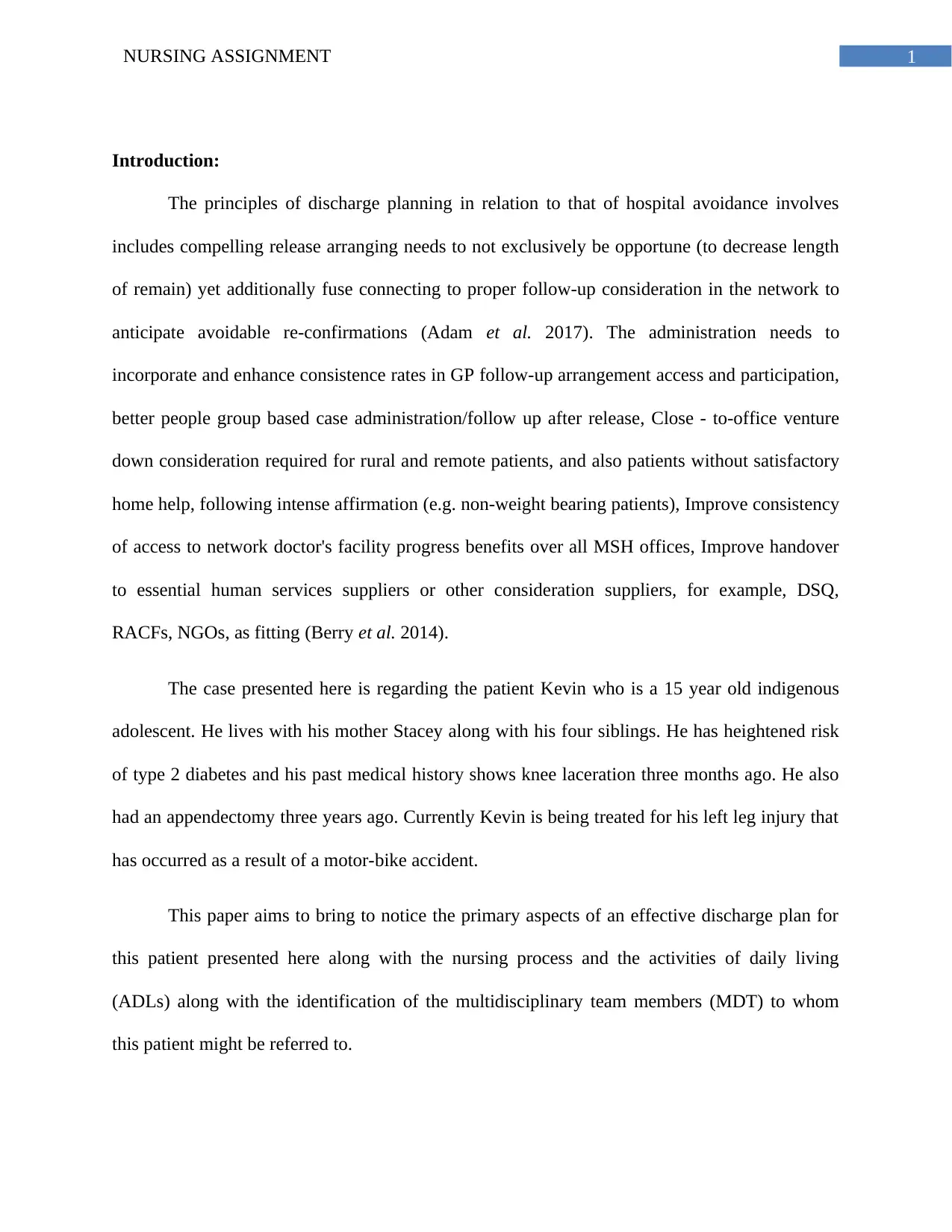
1NURSING ASSIGNMENT
Introduction:
The principles of discharge planning in relation to that of hospital avoidance involves
includes compelling release arranging needs to not exclusively be opportune (to decrease length
of remain) yet additionally fuse connecting to proper follow-up consideration in the network to
anticipate avoidable re-confirmations (Adam et al. 2017). The administration needs to
incorporate and enhance consistence rates in GP follow-up arrangement access and participation,
better people group based case administration/follow up after release, Close - to-office venture
down consideration required for rural and remote patients, and also patients without satisfactory
home help, following intense affirmation (e.g. non-weight bearing patients), Improve consistency
of access to network doctor's facility progress benefits over all MSH offices, Improve handover
to essential human services suppliers or other consideration suppliers, for example, DSQ,
RACFs, NGOs, as fitting (Berry et al. 2014).
The case presented here is regarding the patient Kevin who is a 15 year old indigenous
adolescent. He lives with his mother Stacey along with his four siblings. He has heightened risk
of type 2 diabetes and his past medical history shows knee laceration three months ago. He also
had an appendectomy three years ago. Currently Kevin is being treated for his left leg injury that
has occurred as a result of a motor-bike accident.
This paper aims to bring to notice the primary aspects of an effective discharge plan for
this patient presented here along with the nursing process and the activities of daily living
(ADLs) along with the identification of the multidisciplinary team members (MDT) to whom
this patient might be referred to.
Introduction:
The principles of discharge planning in relation to that of hospital avoidance involves
includes compelling release arranging needs to not exclusively be opportune (to decrease length
of remain) yet additionally fuse connecting to proper follow-up consideration in the network to
anticipate avoidable re-confirmations (Adam et al. 2017). The administration needs to
incorporate and enhance consistence rates in GP follow-up arrangement access and participation,
better people group based case administration/follow up after release, Close - to-office venture
down consideration required for rural and remote patients, and also patients without satisfactory
home help, following intense affirmation (e.g. non-weight bearing patients), Improve consistency
of access to network doctor's facility progress benefits over all MSH offices, Improve handover
to essential human services suppliers or other consideration suppliers, for example, DSQ,
RACFs, NGOs, as fitting (Berry et al. 2014).
The case presented here is regarding the patient Kevin who is a 15 year old indigenous
adolescent. He lives with his mother Stacey along with his four siblings. He has heightened risk
of type 2 diabetes and his past medical history shows knee laceration three months ago. He also
had an appendectomy three years ago. Currently Kevin is being treated for his left leg injury that
has occurred as a result of a motor-bike accident.
This paper aims to bring to notice the primary aspects of an effective discharge plan for
this patient presented here along with the nursing process and the activities of daily living
(ADLs) along with the identification of the multidisciplinary team members (MDT) to whom
this patient might be referred to.
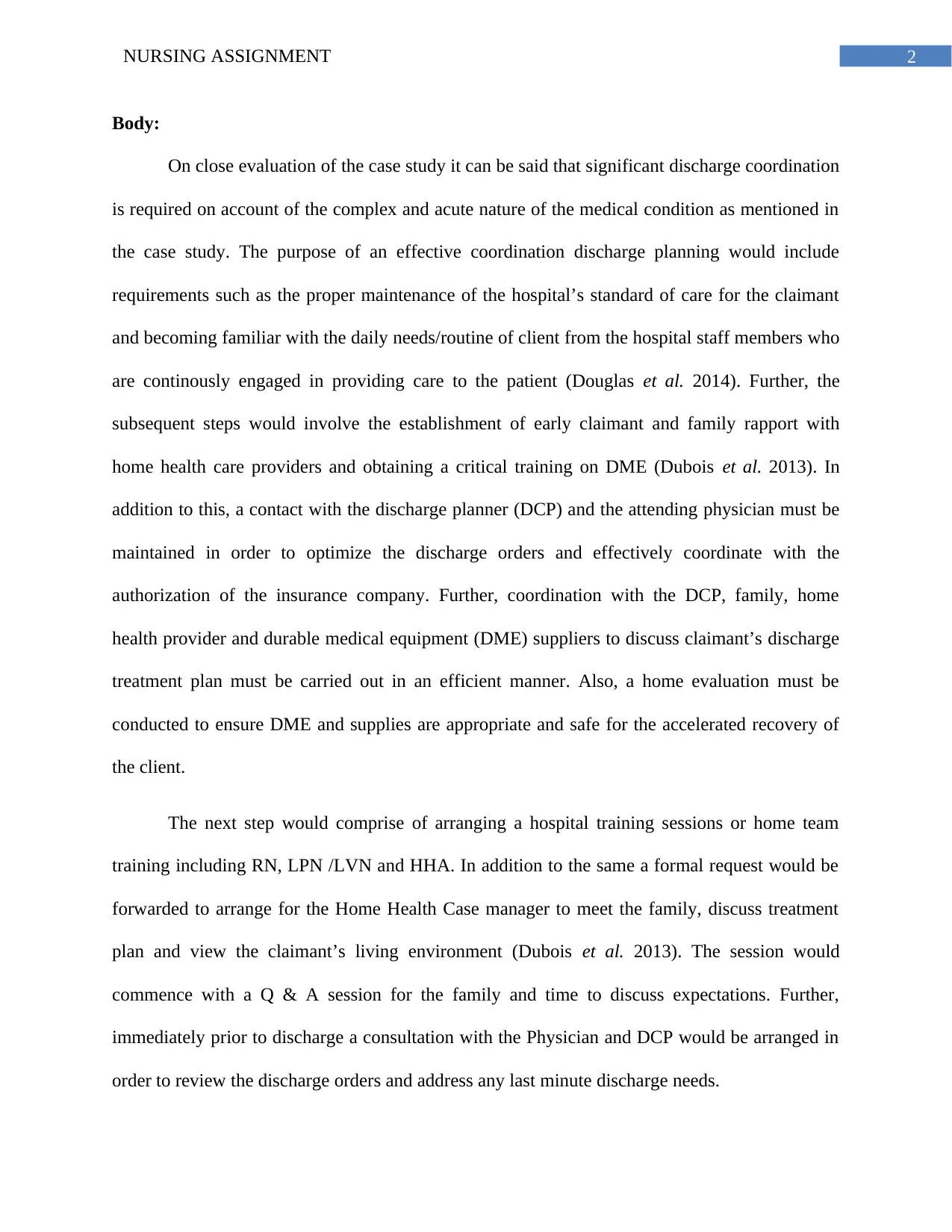
2NURSING ASSIGNMENT
Body:
On close evaluation of the case study it can be said that significant discharge coordination
is required on account of the complex and acute nature of the medical condition as mentioned in
the case study. The purpose of an effective coordination discharge planning would include
requirements such as the proper maintenance of the hospital’s standard of care for the claimant
and becoming familiar with the daily needs/routine of client from the hospital staff members who
are continously engaged in providing care to the patient (Douglas et al. 2014). Further, the
subsequent steps would involve the establishment of early claimant and family rapport with
home health care providers and obtaining a critical training on DME (Dubois et al. 2013). In
addition to this, a contact with the discharge planner (DCP) and the attending physician must be
maintained in order to optimize the discharge orders and effectively coordinate with the
authorization of the insurance company. Further, coordination with the DCP, family, home
health provider and durable medical equipment (DME) suppliers to discuss claimant’s discharge
treatment plan must be carried out in an efficient manner. Also, a home evaluation must be
conducted to ensure DME and supplies are appropriate and safe for the accelerated recovery of
the client.
The next step would comprise of arranging a hospital training sessions or home team
training including RN, LPN /LVN and HHA. In addition to the same a formal request would be
forwarded to arrange for the Home Health Case manager to meet the family, discuss treatment
plan and view the claimant’s living environment (Dubois et al. 2013). The session would
commence with a Q & A session for the family and time to discuss expectations. Further,
immediately prior to discharge a consultation with the Physician and DCP would be arranged in
order to review the discharge orders and address any last minute discharge needs.
Body:
On close evaluation of the case study it can be said that significant discharge coordination
is required on account of the complex and acute nature of the medical condition as mentioned in
the case study. The purpose of an effective coordination discharge planning would include
requirements such as the proper maintenance of the hospital’s standard of care for the claimant
and becoming familiar with the daily needs/routine of client from the hospital staff members who
are continously engaged in providing care to the patient (Douglas et al. 2014). Further, the
subsequent steps would involve the establishment of early claimant and family rapport with
home health care providers and obtaining a critical training on DME (Dubois et al. 2013). In
addition to this, a contact with the discharge planner (DCP) and the attending physician must be
maintained in order to optimize the discharge orders and effectively coordinate with the
authorization of the insurance company. Further, coordination with the DCP, family, home
health provider and durable medical equipment (DME) suppliers to discuss claimant’s discharge
treatment plan must be carried out in an efficient manner. Also, a home evaluation must be
conducted to ensure DME and supplies are appropriate and safe for the accelerated recovery of
the client.
The next step would comprise of arranging a hospital training sessions or home team
training including RN, LPN /LVN and HHA. In addition to the same a formal request would be
forwarded to arrange for the Home Health Case manager to meet the family, discuss treatment
plan and view the claimant’s living environment (Dubois et al. 2013). The session would
commence with a Q & A session for the family and time to discuss expectations. Further,
immediately prior to discharge a consultation with the Physician and DCP would be arranged in
order to review the discharge orders and address any last minute discharge needs.
⊘ This is a preview!⊘
Do you want full access?
Subscribe today to unlock all pages.

Trusted by 1+ million students worldwide
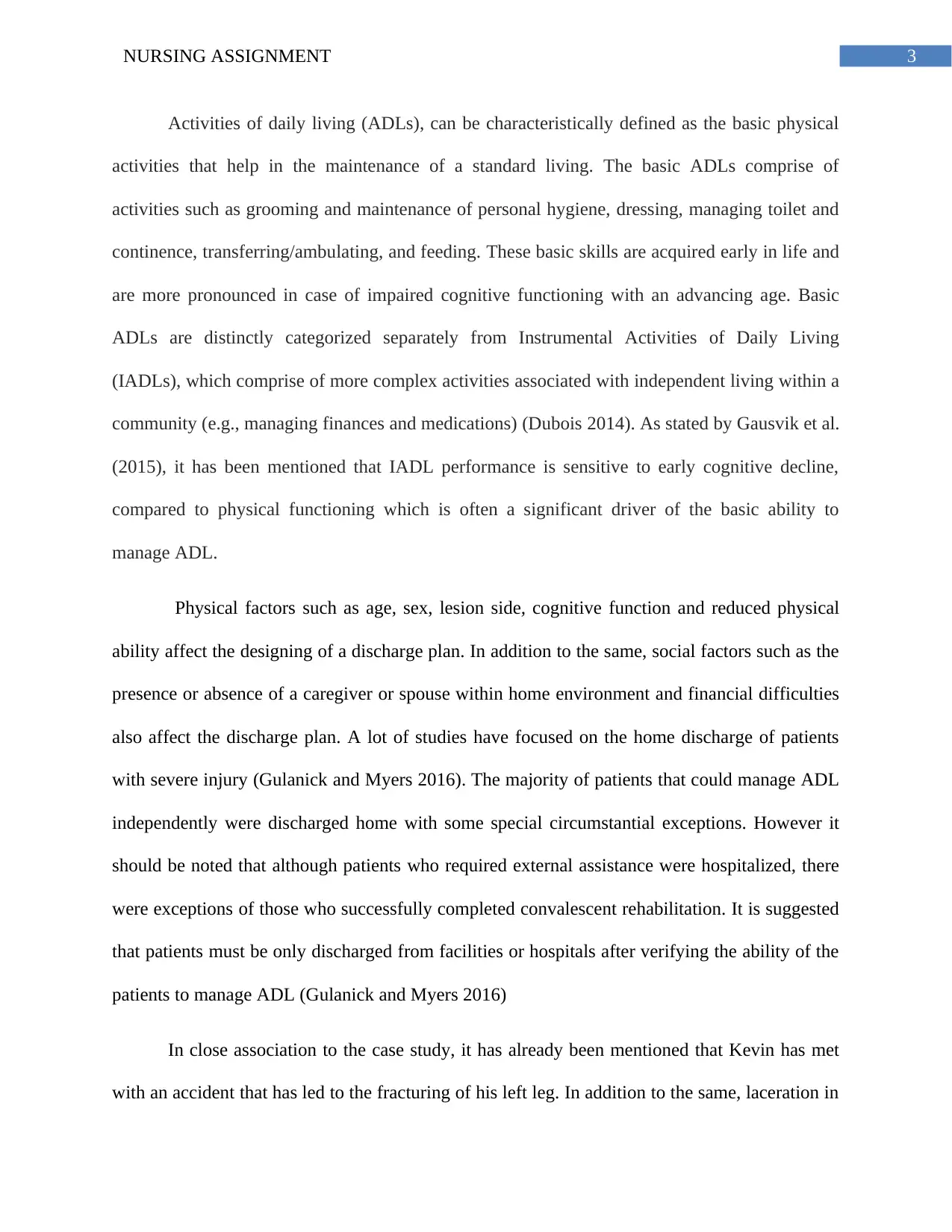
3NURSING ASSIGNMENT
Activities of daily living (ADLs), can be characteristically defined as the basic physical
activities that help in the maintenance of a standard living. The basic ADLs comprise of
activities such as grooming and maintenance of personal hygiene, dressing, managing toilet and
continence, transferring/ambulating, and feeding. These basic skills are acquired early in life and
are more pronounced in case of impaired cognitive functioning with an advancing age. Basic
ADLs are distinctly categorized separately from Instrumental Activities of Daily Living
(IADLs), which comprise of more complex activities associated with independent living within a
community (e.g., managing finances and medications) (Dubois 2014). As stated by Gausvik et al.
(2015), it has been mentioned that IADL performance is sensitive to early cognitive decline,
compared to physical functioning which is often a significant driver of the basic ability to
manage ADL.
Physical factors such as age, sex, lesion side, cognitive function and reduced physical
ability affect the designing of a discharge plan. In addition to the same, social factors such as the
presence or absence of a caregiver or spouse within home environment and financial difficulties
also affect the discharge plan. A lot of studies have focused on the home discharge of patients
with severe injury (Gulanick and Myers 2016). The majority of patients that could manage ADL
independently were discharged home with some special circumstantial exceptions. However it
should be noted that although patients who required external assistance were hospitalized, there
were exceptions of those who successfully completed convalescent rehabilitation. It is suggested
that patients must be only discharged from facilities or hospitals after verifying the ability of the
patients to manage ADL (Gulanick and Myers 2016)
In close association to the case study, it has already been mentioned that Kevin has met
with an accident that has led to the fracturing of his left leg. In addition to the same, laceration in
Activities of daily living (ADLs), can be characteristically defined as the basic physical
activities that help in the maintenance of a standard living. The basic ADLs comprise of
activities such as grooming and maintenance of personal hygiene, dressing, managing toilet and
continence, transferring/ambulating, and feeding. These basic skills are acquired early in life and
are more pronounced in case of impaired cognitive functioning with an advancing age. Basic
ADLs are distinctly categorized separately from Instrumental Activities of Daily Living
(IADLs), which comprise of more complex activities associated with independent living within a
community (e.g., managing finances and medications) (Dubois 2014). As stated by Gausvik et al.
(2015), it has been mentioned that IADL performance is sensitive to early cognitive decline,
compared to physical functioning which is often a significant driver of the basic ability to
manage ADL.
Physical factors such as age, sex, lesion side, cognitive function and reduced physical
ability affect the designing of a discharge plan. In addition to the same, social factors such as the
presence or absence of a caregiver or spouse within home environment and financial difficulties
also affect the discharge plan. A lot of studies have focused on the home discharge of patients
with severe injury (Gulanick and Myers 2016). The majority of patients that could manage ADL
independently were discharged home with some special circumstantial exceptions. However it
should be noted that although patients who required external assistance were hospitalized, there
were exceptions of those who successfully completed convalescent rehabilitation. It is suggested
that patients must be only discharged from facilities or hospitals after verifying the ability of the
patients to manage ADL (Gulanick and Myers 2016)
In close association to the case study, it has already been mentioned that Kevin has met
with an accident that has led to the fracturing of his left leg. In addition to the same, laceration in
Paraphrase This Document
Need a fresh take? Get an instant paraphrase of this document with our AI Paraphraser
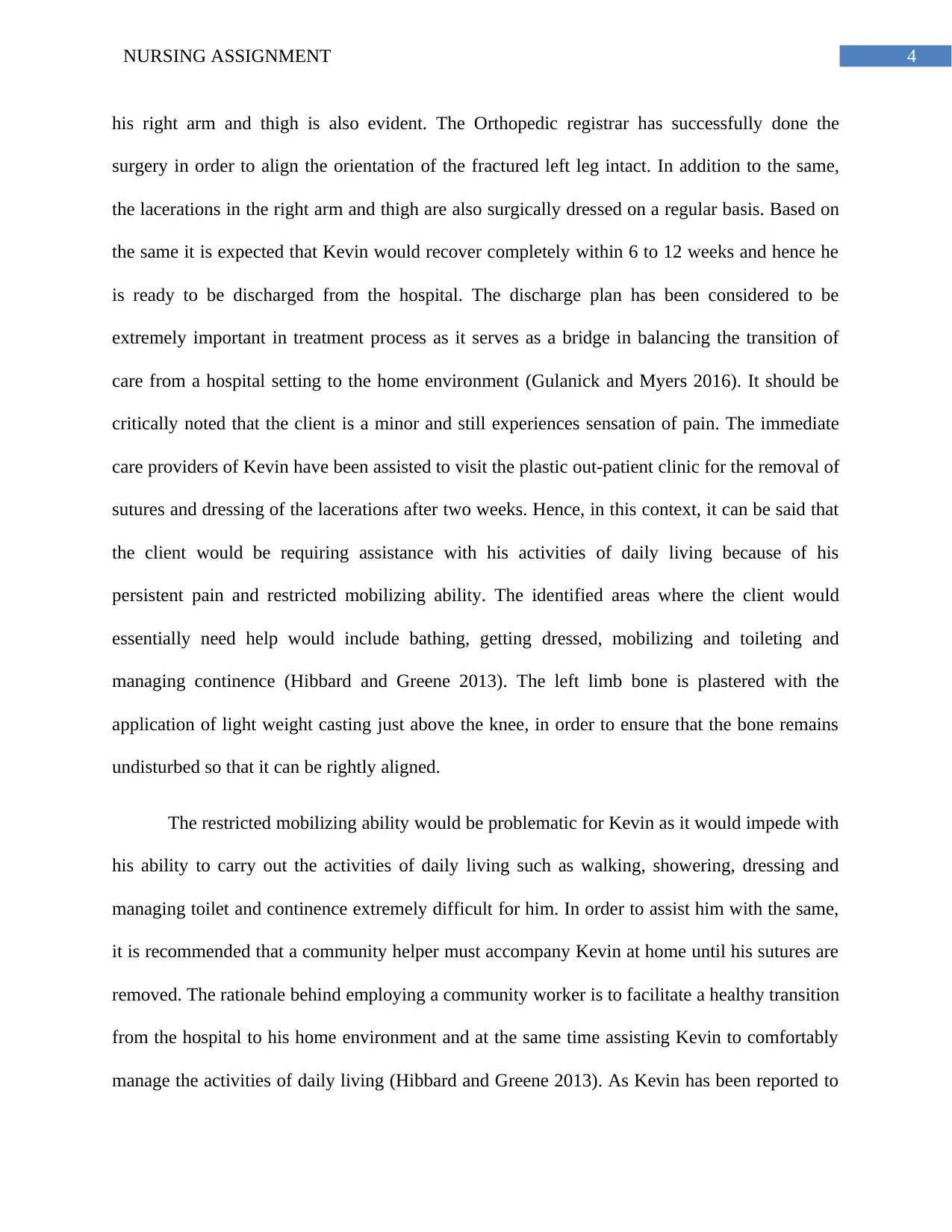
4NURSING ASSIGNMENT
his right arm and thigh is also evident. The Orthopedic registrar has successfully done the
surgery in order to align the orientation of the fractured left leg intact. In addition to the same,
the lacerations in the right arm and thigh are also surgically dressed on a regular basis. Based on
the same it is expected that Kevin would recover completely within 6 to 12 weeks and hence he
is ready to be discharged from the hospital. The discharge plan has been considered to be
extremely important in treatment process as it serves as a bridge in balancing the transition of
care from a hospital setting to the home environment (Gulanick and Myers 2016). It should be
critically noted that the client is a minor and still experiences sensation of pain. The immediate
care providers of Kevin have been assisted to visit the plastic out-patient clinic for the removal of
sutures and dressing of the lacerations after two weeks. Hence, in this context, it can be said that
the client would be requiring assistance with his activities of daily living because of his
persistent pain and restricted mobilizing ability. The identified areas where the client would
essentially need help would include bathing, getting dressed, mobilizing and toileting and
managing continence (Hibbard and Greene 2013). The left limb bone is plastered with the
application of light weight casting just above the knee, in order to ensure that the bone remains
undisturbed so that it can be rightly aligned.
The restricted mobilizing ability would be problematic for Kevin as it would impede with
his ability to carry out the activities of daily living such as walking, showering, dressing and
managing toilet and continence extremely difficult for him. In order to assist him with the same,
it is recommended that a community helper must accompany Kevin at home until his sutures are
removed. The rationale behind employing a community worker is to facilitate a healthy transition
from the hospital to his home environment and at the same time assisting Kevin to comfortably
manage the activities of daily living (Hibbard and Greene 2013). As Kevin has been reported to
his right arm and thigh is also evident. The Orthopedic registrar has successfully done the
surgery in order to align the orientation of the fractured left leg intact. In addition to the same,
the lacerations in the right arm and thigh are also surgically dressed on a regular basis. Based on
the same it is expected that Kevin would recover completely within 6 to 12 weeks and hence he
is ready to be discharged from the hospital. The discharge plan has been considered to be
extremely important in treatment process as it serves as a bridge in balancing the transition of
care from a hospital setting to the home environment (Gulanick and Myers 2016). It should be
critically noted that the client is a minor and still experiences sensation of pain. The immediate
care providers of Kevin have been assisted to visit the plastic out-patient clinic for the removal of
sutures and dressing of the lacerations after two weeks. Hence, in this context, it can be said that
the client would be requiring assistance with his activities of daily living because of his
persistent pain and restricted mobilizing ability. The identified areas where the client would
essentially need help would include bathing, getting dressed, mobilizing and toileting and
managing continence (Hibbard and Greene 2013). The left limb bone is plastered with the
application of light weight casting just above the knee, in order to ensure that the bone remains
undisturbed so that it can be rightly aligned.
The restricted mobilizing ability would be problematic for Kevin as it would impede with
his ability to carry out the activities of daily living such as walking, showering, dressing and
managing toilet and continence extremely difficult for him. In order to assist him with the same,
it is recommended that a community helper must accompany Kevin at home until his sutures are
removed. The rationale behind employing a community worker is to facilitate a healthy transition
from the hospital to his home environment and at the same time assisting Kevin to comfortably
manage the activities of daily living (Hibbard and Greene 2013). As Kevin has been reported to
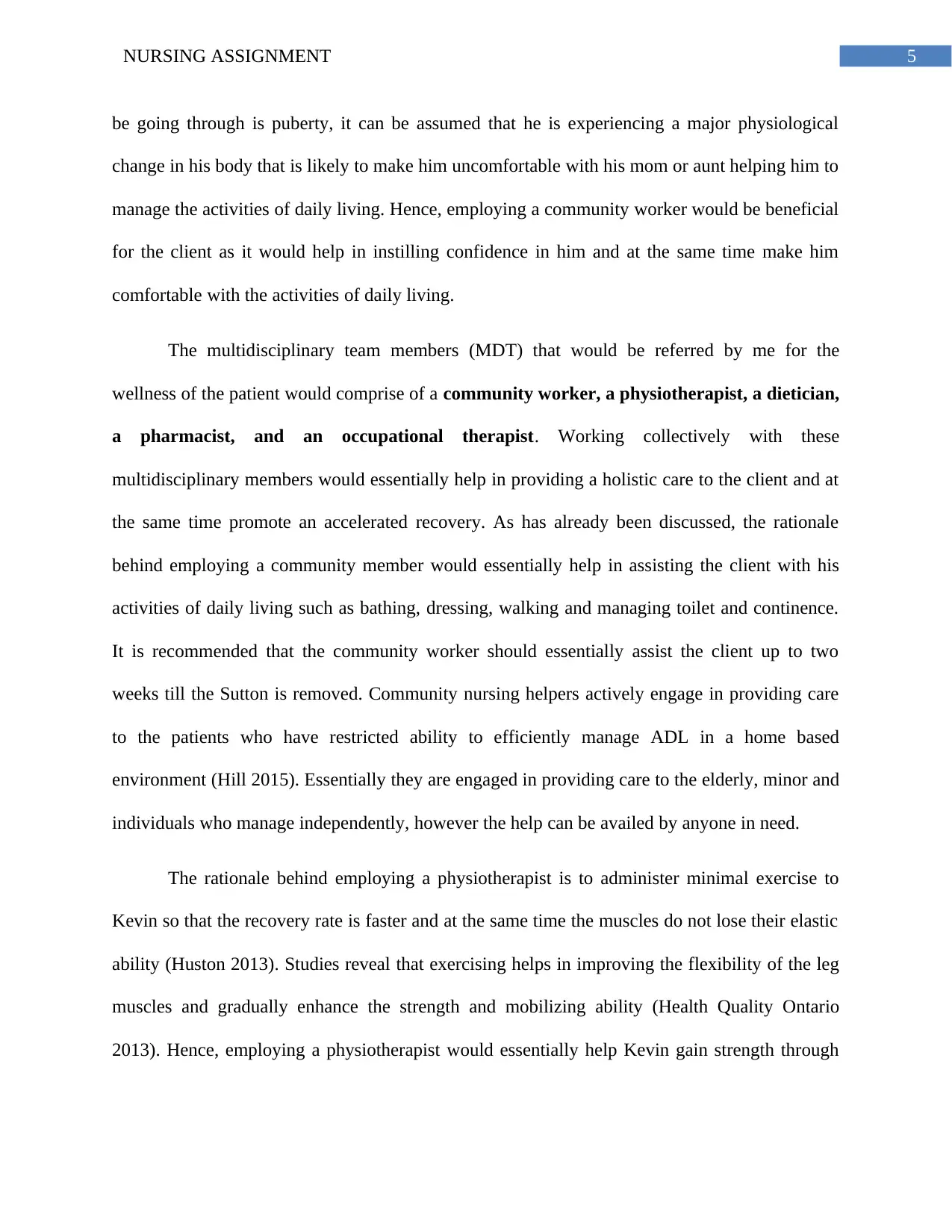
5NURSING ASSIGNMENT
be going through is puberty, it can be assumed that he is experiencing a major physiological
change in his body that is likely to make him uncomfortable with his mom or aunt helping him to
manage the activities of daily living. Hence, employing a community worker would be beneficial
for the client as it would help in instilling confidence in him and at the same time make him
comfortable with the activities of daily living.
The multidisciplinary team members (MDT) that would be referred by me for the
wellness of the patient would comprise of a community worker, a physiotherapist, a dietician,
a pharmacist, and an occupational therapist. Working collectively with these
multidisciplinary members would essentially help in providing a holistic care to the client and at
the same time promote an accelerated recovery. As has already been discussed, the rationale
behind employing a community member would essentially help in assisting the client with his
activities of daily living such as bathing, dressing, walking and managing toilet and continence.
It is recommended that the community worker should essentially assist the client up to two
weeks till the Sutton is removed. Community nursing helpers actively engage in providing care
to the patients who have restricted ability to efficiently manage ADL in a home based
environment (Hill 2015). Essentially they are engaged in providing care to the elderly, minor and
individuals who manage independently, however the help can be availed by anyone in need.
The rationale behind employing a physiotherapist is to administer minimal exercise to
Kevin so that the recovery rate is faster and at the same time the muscles do not lose their elastic
ability (Huston 2013). Studies reveal that exercising helps in improving the flexibility of the leg
muscles and gradually enhance the strength and mobilizing ability (Health Quality Ontario
2013). Hence, employing a physiotherapist would essentially help Kevin gain strength through
be going through is puberty, it can be assumed that he is experiencing a major physiological
change in his body that is likely to make him uncomfortable with his mom or aunt helping him to
manage the activities of daily living. Hence, employing a community worker would be beneficial
for the client as it would help in instilling confidence in him and at the same time make him
comfortable with the activities of daily living.
The multidisciplinary team members (MDT) that would be referred by me for the
wellness of the patient would comprise of a community worker, a physiotherapist, a dietician,
a pharmacist, and an occupational therapist. Working collectively with these
multidisciplinary members would essentially help in providing a holistic care to the client and at
the same time promote an accelerated recovery. As has already been discussed, the rationale
behind employing a community member would essentially help in assisting the client with his
activities of daily living such as bathing, dressing, walking and managing toilet and continence.
It is recommended that the community worker should essentially assist the client up to two
weeks till the Sutton is removed. Community nursing helpers actively engage in providing care
to the patients who have restricted ability to efficiently manage ADL in a home based
environment (Hill 2015). Essentially they are engaged in providing care to the elderly, minor and
individuals who manage independently, however the help can be availed by anyone in need.
The rationale behind employing a physiotherapist is to administer minimal exercise to
Kevin so that the recovery rate is faster and at the same time the muscles do not lose their elastic
ability (Huston 2013). Studies reveal that exercising helps in improving the flexibility of the leg
muscles and gradually enhance the strength and mobilizing ability (Health Quality Ontario
2013). Hence, employing a physiotherapist would essentially help Kevin gain strength through
⊘ This is a preview!⊘
Do you want full access?
Subscribe today to unlock all pages.

Trusted by 1+ million students worldwide
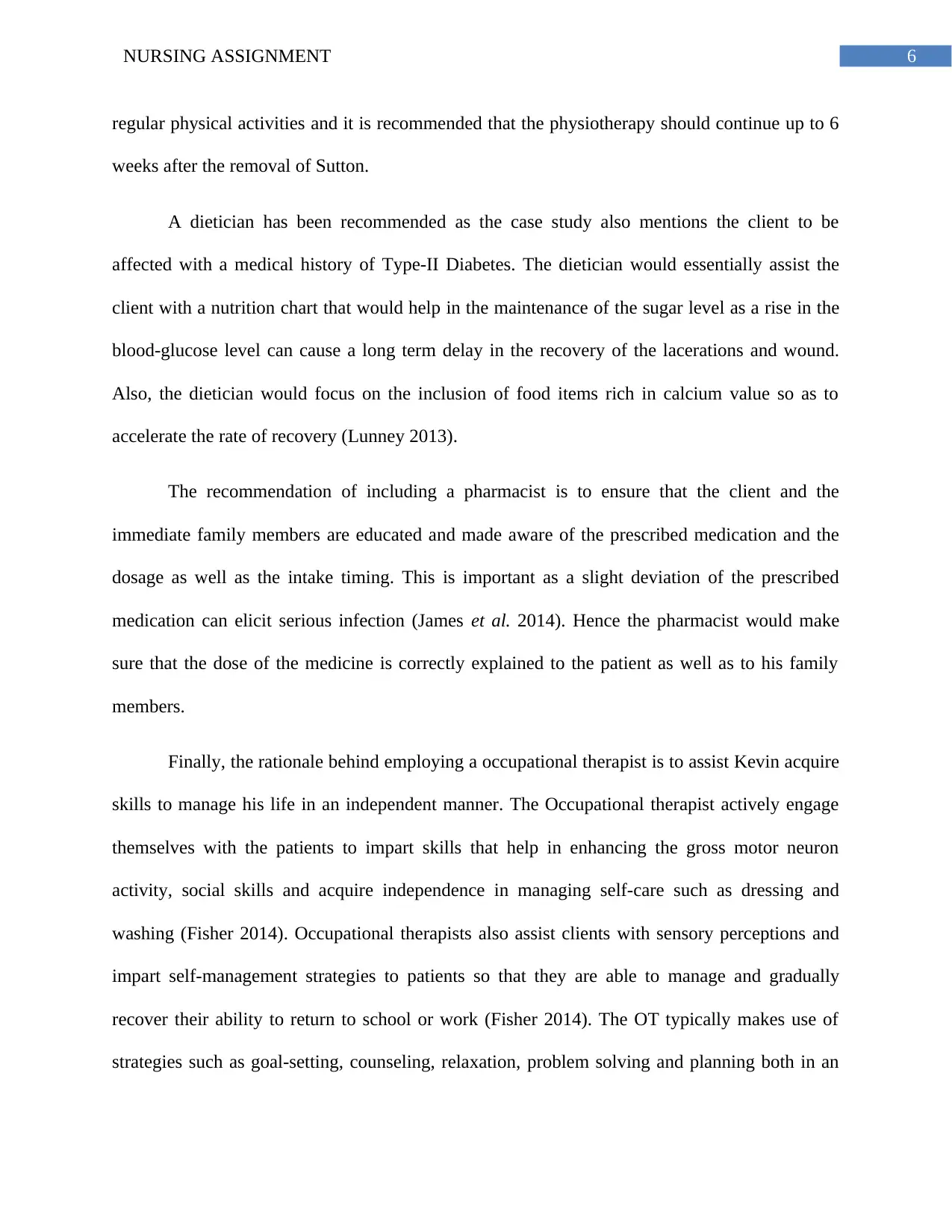
6NURSING ASSIGNMENT
regular physical activities and it is recommended that the physiotherapy should continue up to 6
weeks after the removal of Sutton.
A dietician has been recommended as the case study also mentions the client to be
affected with a medical history of Type-II Diabetes. The dietician would essentially assist the
client with a nutrition chart that would help in the maintenance of the sugar level as a rise in the
blood-glucose level can cause a long term delay in the recovery of the lacerations and wound.
Also, the dietician would focus on the inclusion of food items rich in calcium value so as to
accelerate the rate of recovery (Lunney 2013).
The recommendation of including a pharmacist is to ensure that the client and the
immediate family members are educated and made aware of the prescribed medication and the
dosage as well as the intake timing. This is important as a slight deviation of the prescribed
medication can elicit serious infection (James et al. 2014). Hence the pharmacist would make
sure that the dose of the medicine is correctly explained to the patient as well as to his family
members.
Finally, the rationale behind employing a occupational therapist is to assist Kevin acquire
skills to manage his life in an independent manner. The Occupational therapist actively engage
themselves with the patients to impart skills that help in enhancing the gross motor neuron
activity, social skills and acquire independence in managing self-care such as dressing and
washing (Fisher 2014). Occupational therapists also assist clients with sensory perceptions and
impart self-management strategies to patients so that they are able to manage and gradually
recover their ability to return to school or work (Fisher 2014). The OT typically makes use of
strategies such as goal-setting, counseling, relaxation, problem solving and planning both in an
regular physical activities and it is recommended that the physiotherapy should continue up to 6
weeks after the removal of Sutton.
A dietician has been recommended as the case study also mentions the client to be
affected with a medical history of Type-II Diabetes. The dietician would essentially assist the
client with a nutrition chart that would help in the maintenance of the sugar level as a rise in the
blood-glucose level can cause a long term delay in the recovery of the lacerations and wound.
Also, the dietician would focus on the inclusion of food items rich in calcium value so as to
accelerate the rate of recovery (Lunney 2013).
The recommendation of including a pharmacist is to ensure that the client and the
immediate family members are educated and made aware of the prescribed medication and the
dosage as well as the intake timing. This is important as a slight deviation of the prescribed
medication can elicit serious infection (James et al. 2014). Hence the pharmacist would make
sure that the dose of the medicine is correctly explained to the patient as well as to his family
members.
Finally, the rationale behind employing a occupational therapist is to assist Kevin acquire
skills to manage his life in an independent manner. The Occupational therapist actively engage
themselves with the patients to impart skills that help in enhancing the gross motor neuron
activity, social skills and acquire independence in managing self-care such as dressing and
washing (Fisher 2014). Occupational therapists also assist clients with sensory perceptions and
impart self-management strategies to patients so that they are able to manage and gradually
recover their ability to return to school or work (Fisher 2014). The OT typically makes use of
strategies such as goal-setting, counseling, relaxation, problem solving and planning both in an
Paraphrase This Document
Need a fresh take? Get an instant paraphrase of this document with our AI Paraphraser
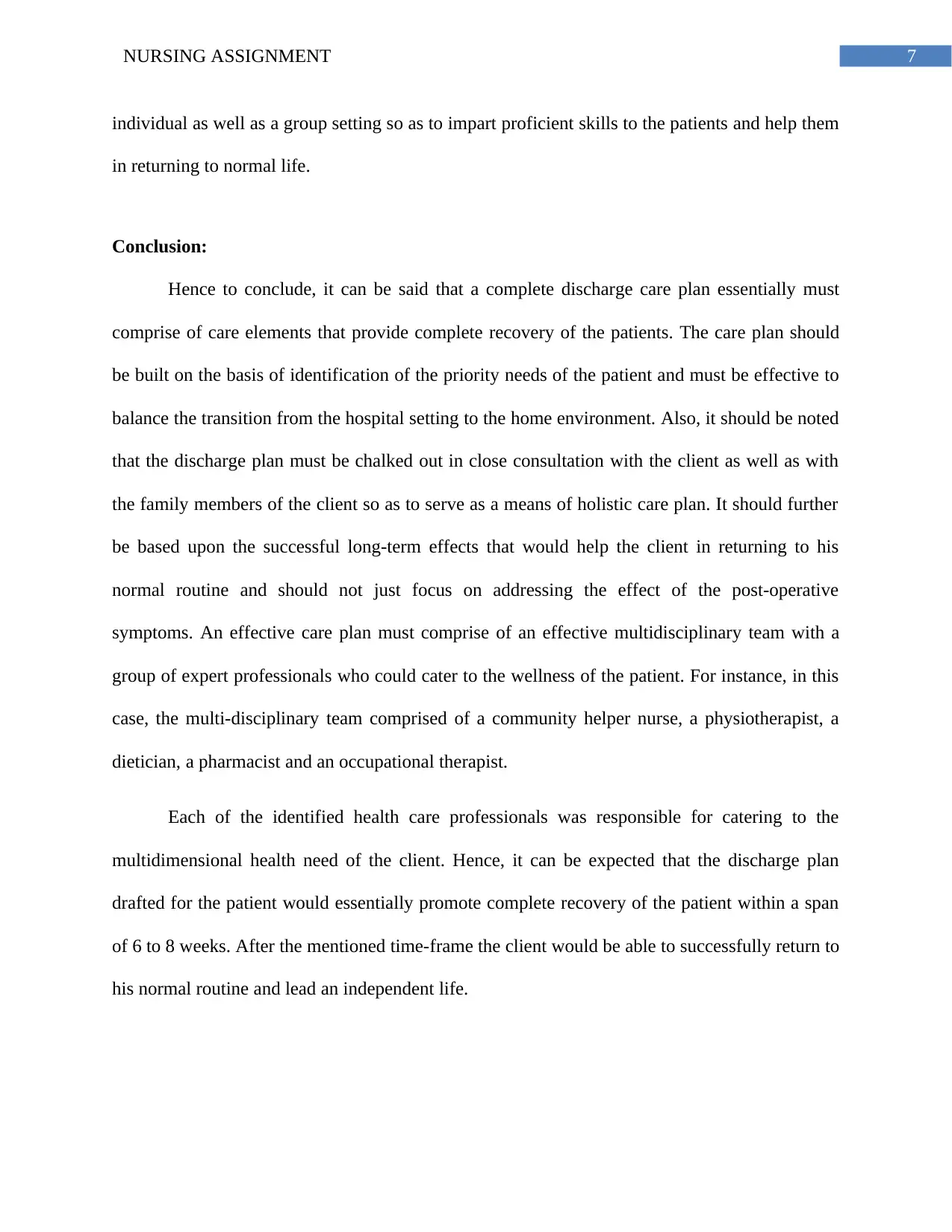
7NURSING ASSIGNMENT
individual as well as a group setting so as to impart proficient skills to the patients and help them
in returning to normal life.
Conclusion:
Hence to conclude, it can be said that a complete discharge care plan essentially must
comprise of care elements that provide complete recovery of the patients. The care plan should
be built on the basis of identification of the priority needs of the patient and must be effective to
balance the transition from the hospital setting to the home environment. Also, it should be noted
that the discharge plan must be chalked out in close consultation with the client as well as with
the family members of the client so as to serve as a means of holistic care plan. It should further
be based upon the successful long-term effects that would help the client in returning to his
normal routine and should not just focus on addressing the effect of the post-operative
symptoms. An effective care plan must comprise of an effective multidisciplinary team with a
group of expert professionals who could cater to the wellness of the patient. For instance, in this
case, the multi-disciplinary team comprised of a community helper nurse, a physiotherapist, a
dietician, a pharmacist and an occupational therapist.
Each of the identified health care professionals was responsible for catering to the
multidimensional health need of the client. Hence, it can be expected that the discharge plan
drafted for the patient would essentially promote complete recovery of the patient within a span
of 6 to 8 weeks. After the mentioned time-frame the client would be able to successfully return to
his normal routine and lead an independent life.
individual as well as a group setting so as to impart proficient skills to the patients and help them
in returning to normal life.
Conclusion:
Hence to conclude, it can be said that a complete discharge care plan essentially must
comprise of care elements that provide complete recovery of the patients. The care plan should
be built on the basis of identification of the priority needs of the patient and must be effective to
balance the transition from the hospital setting to the home environment. Also, it should be noted
that the discharge plan must be chalked out in close consultation with the client as well as with
the family members of the client so as to serve as a means of holistic care plan. It should further
be based upon the successful long-term effects that would help the client in returning to his
normal routine and should not just focus on addressing the effect of the post-operative
symptoms. An effective care plan must comprise of an effective multidisciplinary team with a
group of expert professionals who could cater to the wellness of the patient. For instance, in this
case, the multi-disciplinary team comprised of a community helper nurse, a physiotherapist, a
dietician, a pharmacist and an occupational therapist.
Each of the identified health care professionals was responsible for catering to the
multidimensional health need of the client. Hence, it can be expected that the discharge plan
drafted for the patient would essentially promote complete recovery of the patient within a span
of 6 to 8 weeks. After the mentioned time-frame the client would be able to successfully return to
his normal routine and lead an independent life.
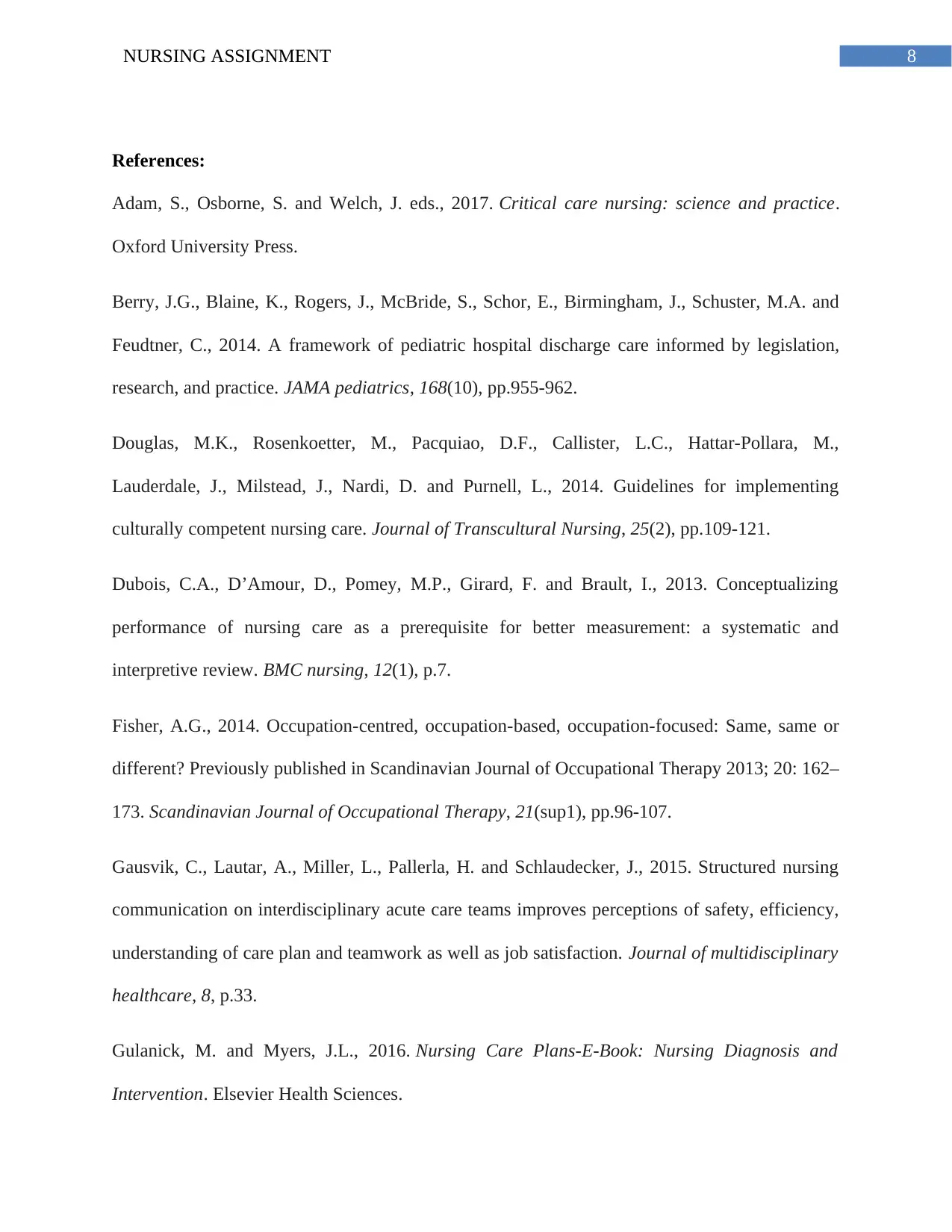
8NURSING ASSIGNMENT
References:
Adam, S., Osborne, S. and Welch, J. eds., 2017. Critical care nursing: science and practice.
Oxford University Press.
Berry, J.G., Blaine, K., Rogers, J., McBride, S., Schor, E., Birmingham, J., Schuster, M.A. and
Feudtner, C., 2014. A framework of pediatric hospital discharge care informed by legislation,
research, and practice. JAMA pediatrics, 168(10), pp.955-962.
Douglas, M.K., Rosenkoetter, M., Pacquiao, D.F., Callister, L.C., Hattar-Pollara, M.,
Lauderdale, J., Milstead, J., Nardi, D. and Purnell, L., 2014. Guidelines for implementing
culturally competent nursing care. Journal of Transcultural Nursing, 25(2), pp.109-121.
Dubois, C.A., D’Amour, D., Pomey, M.P., Girard, F. and Brault, I., 2013. Conceptualizing
performance of nursing care as a prerequisite for better measurement: a systematic and
interpretive review. BMC nursing, 12(1), p.7.
Fisher, A.G., 2014. Occupation-centred, occupation-based, occupation-focused: Same, same or
different? Previously published in Scandinavian Journal of Occupational Therapy 2013; 20: 162–
173. Scandinavian Journal of Occupational Therapy, 21(sup1), pp.96-107.
Gausvik, C., Lautar, A., Miller, L., Pallerla, H. and Schlaudecker, J., 2015. Structured nursing
communication on interdisciplinary acute care teams improves perceptions of safety, efficiency,
understanding of care plan and teamwork as well as job satisfaction. Journal of multidisciplinary
healthcare, 8, p.33.
Gulanick, M. and Myers, J.L., 2016. Nursing Care Plans-E-Book: Nursing Diagnosis and
Intervention. Elsevier Health Sciences.
References:
Adam, S., Osborne, S. and Welch, J. eds., 2017. Critical care nursing: science and practice.
Oxford University Press.
Berry, J.G., Blaine, K., Rogers, J., McBride, S., Schor, E., Birmingham, J., Schuster, M.A. and
Feudtner, C., 2014. A framework of pediatric hospital discharge care informed by legislation,
research, and practice. JAMA pediatrics, 168(10), pp.955-962.
Douglas, M.K., Rosenkoetter, M., Pacquiao, D.F., Callister, L.C., Hattar-Pollara, M.,
Lauderdale, J., Milstead, J., Nardi, D. and Purnell, L., 2014. Guidelines for implementing
culturally competent nursing care. Journal of Transcultural Nursing, 25(2), pp.109-121.
Dubois, C.A., D’Amour, D., Pomey, M.P., Girard, F. and Brault, I., 2013. Conceptualizing
performance of nursing care as a prerequisite for better measurement: a systematic and
interpretive review. BMC nursing, 12(1), p.7.
Fisher, A.G., 2014. Occupation-centred, occupation-based, occupation-focused: Same, same or
different? Previously published in Scandinavian Journal of Occupational Therapy 2013; 20: 162–
173. Scandinavian Journal of Occupational Therapy, 21(sup1), pp.96-107.
Gausvik, C., Lautar, A., Miller, L., Pallerla, H. and Schlaudecker, J., 2015. Structured nursing
communication on interdisciplinary acute care teams improves perceptions of safety, efficiency,
understanding of care plan and teamwork as well as job satisfaction. Journal of multidisciplinary
healthcare, 8, p.33.
Gulanick, M. and Myers, J.L., 2016. Nursing Care Plans-E-Book: Nursing Diagnosis and
Intervention. Elsevier Health Sciences.
⊘ This is a preview!⊘
Do you want full access?
Subscribe today to unlock all pages.

Trusted by 1+ million students worldwide
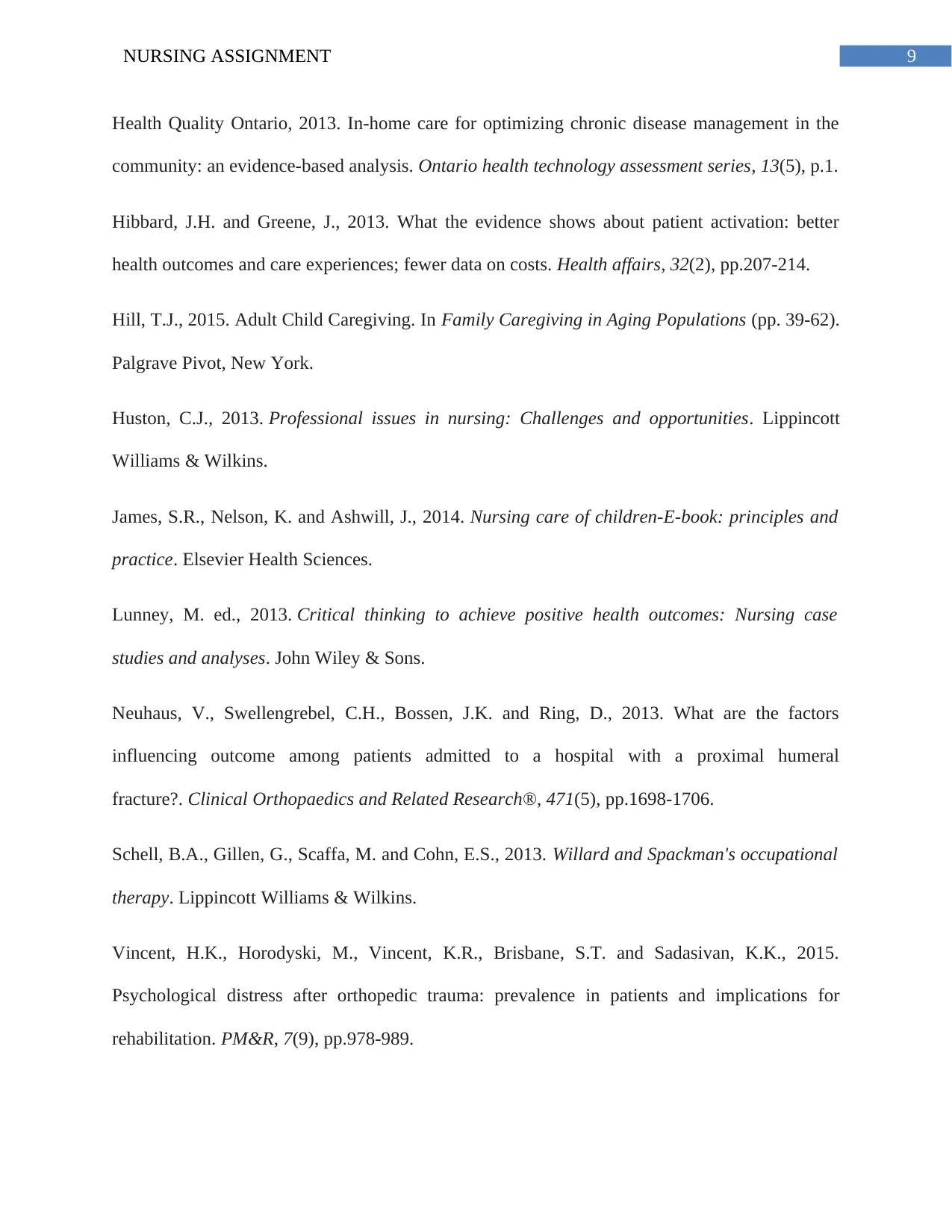
9NURSING ASSIGNMENT
Health Quality Ontario, 2013. In-home care for optimizing chronic disease management in the
community: an evidence-based analysis. Ontario health technology assessment series, 13(5), p.1.
Hibbard, J.H. and Greene, J., 2013. What the evidence shows about patient activation: better
health outcomes and care experiences; fewer data on costs. Health affairs, 32(2), pp.207-214.
Hill, T.J., 2015. Adult Child Caregiving. In Family Caregiving in Aging Populations (pp. 39-62).
Palgrave Pivot, New York.
Huston, C.J., 2013. Professional issues in nursing: Challenges and opportunities. Lippincott
Williams & Wilkins.
James, S.R., Nelson, K. and Ashwill, J., 2014. Nursing care of children-E-book: principles and
practice. Elsevier Health Sciences.
Lunney, M. ed., 2013. Critical thinking to achieve positive health outcomes: Nursing case
studies and analyses. John Wiley & Sons.
Neuhaus, V., Swellengrebel, C.H., Bossen, J.K. and Ring, D., 2013. What are the factors
influencing outcome among patients admitted to a hospital with a proximal humeral
fracture?. Clinical Orthopaedics and Related Research®, 471(5), pp.1698-1706.
Schell, B.A., Gillen, G., Scaffa, M. and Cohn, E.S., 2013. Willard and Spackman's occupational
therapy. Lippincott Williams & Wilkins.
Vincent, H.K., Horodyski, M., Vincent, K.R., Brisbane, S.T. and Sadasivan, K.K., 2015.
Psychological distress after orthopedic trauma: prevalence in patients and implications for
rehabilitation. PM&R, 7(9), pp.978-989.
Health Quality Ontario, 2013. In-home care for optimizing chronic disease management in the
community: an evidence-based analysis. Ontario health technology assessment series, 13(5), p.1.
Hibbard, J.H. and Greene, J., 2013. What the evidence shows about patient activation: better
health outcomes and care experiences; fewer data on costs. Health affairs, 32(2), pp.207-214.
Hill, T.J., 2015. Adult Child Caregiving. In Family Caregiving in Aging Populations (pp. 39-62).
Palgrave Pivot, New York.
Huston, C.J., 2013. Professional issues in nursing: Challenges and opportunities. Lippincott
Williams & Wilkins.
James, S.R., Nelson, K. and Ashwill, J., 2014. Nursing care of children-E-book: principles and
practice. Elsevier Health Sciences.
Lunney, M. ed., 2013. Critical thinking to achieve positive health outcomes: Nursing case
studies and analyses. John Wiley & Sons.
Neuhaus, V., Swellengrebel, C.H., Bossen, J.K. and Ring, D., 2013. What are the factors
influencing outcome among patients admitted to a hospital with a proximal humeral
fracture?. Clinical Orthopaedics and Related Research®, 471(5), pp.1698-1706.
Schell, B.A., Gillen, G., Scaffa, M. and Cohn, E.S., 2013. Willard and Spackman's occupational
therapy. Lippincott Williams & Wilkins.
Vincent, H.K., Horodyski, M., Vincent, K.R., Brisbane, S.T. and Sadasivan, K.K., 2015.
Psychological distress after orthopedic trauma: prevalence in patients and implications for
rehabilitation. PM&R, 7(9), pp.978-989.
1 out of 10
Related Documents
Your All-in-One AI-Powered Toolkit for Academic Success.
+13062052269
info@desklib.com
Available 24*7 on WhatsApp / Email
![[object Object]](/_next/static/media/star-bottom.7253800d.svg)
Unlock your academic potential
Copyright © 2020–2025 A2Z Services. All Rights Reserved. Developed and managed by ZUCOL.





